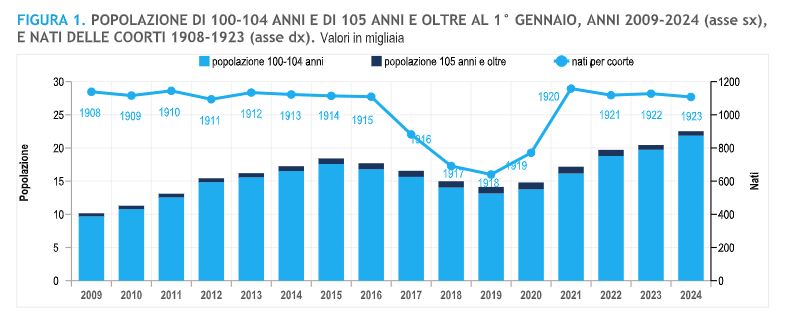ROME (ITALPRESS) – The number of centenarians living in Italy is increasing: as of January 1, 2014, there are 22,552, 81 percent of whom are female. Considering that as of January 1, 2014 there were 17,252, the growth in a single decade was more than 30 percent. This was announced by Istat, adding that as of the same date, there were 677 residents aged 105 years or older (semi-supercentenarians). The latter record a sharp decrease compared to the 1,047 individuals detected in 2020 (peak reached since the beginning of the survey) for a structural reason: in the last four years, survivors of the generations born in the years of World War I, marked by a contingently lower birth rate, have gradually entered the over-105 age group. This structural effect had affected previous generations between 2016 and 2019, leading to a decline in the population aged 100 and older, which has resumed substantial growth since 2020, registering an increase of nearly 60 percent between 2019 and 2024.
Also according to the Statistical Institute’s analysis, the gender ratio among semi-supercentenarians is heavily skewed in favor of women: in fact, there are 600 of them, or 89 percent of the total, compared to 77 men (11 percent). As of January 1, 2024, there are 21 residents who have reached and surpassed the 110-year mark (super-supercentenarians). Confirming greater female longevity only one of them is male.
In the 15-year survey of the semi-super and supercentenarian population, i.e., 2009-2024, a total of 8,521 individuals have crossed the 105-year age threshold, of whom 7,536 are women (88 percent) and 985 are men (12 percent). The most common first names are Joseph for men and Mary for women, followed by Anthony and Rose in second place and John and Anne in third. Both women and men who have reached 105 years of age are almost all in the marital status of widowhood (86 percent and 81 percent respectively).
The largest differences are found among the single and unmarried, with males accounting for 6 percent and females 12 percent, but especially among the married and married where women account for only 1 percent and men 13 percent, due to the greater female longevity that more frequently leads male individuals to spend the last years of their lives still with their partners.
A total of 200 individuals passed the age of 110 years between 2009 and 2024, 92% of whom were female. As of January 1, 2009, only 10 of these were alive, while as many as 21 are still alive as of January 1, 2024, for a growth that has more than doubled in 15 years.
At the beginning of 2024, the oldest person is a woman resident of Emilia-Romagna; in October this year she was able to cross the 114-year age mark. Among men, the oldest living person as of January 1, 2024 was an individual residing in Molise aged 110, who subsequently passed away earlier this year. As of late October, the ‘new’ dean resides in Basilicata and has also passed 110 years of age.
Thus, the absolute records for Italian male and female longevity, respectively held by Antonio Todde (resident of Sardinia) who died in 2002 a few weeks before turning 113, and especially by Emma Morano (resident of Piedmont) who died in 2017 at the age of 117 and who, while alive, had held the record as the world’s longest-lived contemporary woman, remain unbeaten.
Today that record is held worldwide by John Alfred Tinniswood, a British citizen, among men (112 years of age) and Tomiko Itooka, a Japanese citizen, among women (116 years of age). By far, since there has been an officially recognized international record, the longest-lived woman in history was Jeanne Calment, a French citizen who died in 1997 at the age of 122. The longest-lived man, on the other hand, was Jiroemon Kimura, a Japanese citizen who died in 2013 at the age of 116.
The more than 22,000 centenarians living as of January 1, 2024 are heterogeneously distributed across the territory. Lombardy is the region with the highest presence in absolute value, with more than 3 thousand residents, followed by Lazio and Emilia-Romagna, which have more than 2 thousand. Similar discourse for semi-supercentenarians who are concentrated in Lombardy with more than 100 residents, then in Emilia-Romagna and Veneto with more than 60 individuals.
In relative terms, the territorial representation of the centenarian population changes.
Liguria, in fact, is the region with the highest concentration of centenarians, 61 per 100,000 residents, followed by Molise (58) and Friuli Venezia-Giulia (54). Lombardy with a value of 34 per 100 thousand ranks in the last positions, also below the national value (38 per 100 thousand).
Limiting the analysis to the semi-supercentenarian population alone, however, it is Molise that has the highest concentration, 3.1 per 100 thousand residents, followed by Liguria (2.4) and Basilicata (2.1).
– Istat press office photo –
(ITALPRESS).

